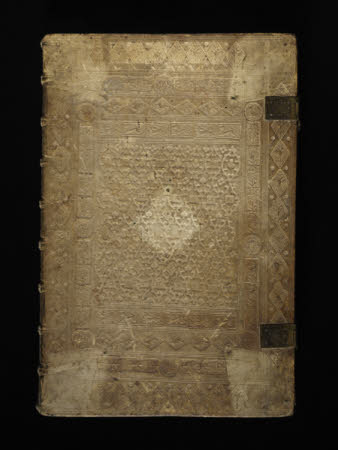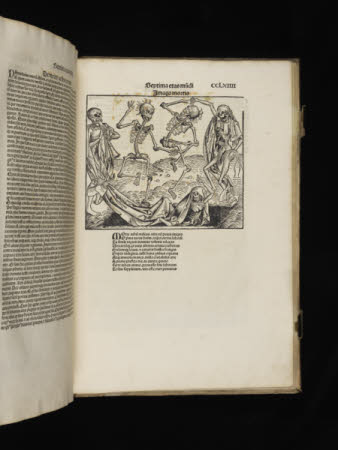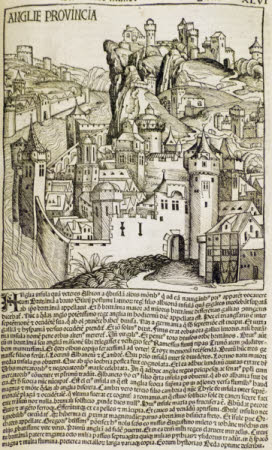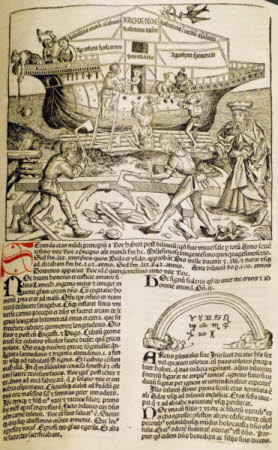The Nuremberg Chronicle (Liber Chronicarum)
Hartmann Schedel
Category
Books
Date
1493
Materials
Ink and paper, pigskin over wooden boards
Measurements
49 x 33 x 11 cm
Place of origin
Nuremberg
Order this imageCollection
Saltram, Devon
NT 3069418
Caption
When this volume was first published in 1493, few people had held an illustrated printed book in their hands. A richly illustrated secular work, it was published in both Latin and German in Nuremberg and subsequently became known in English as The Nuremberg Chronicle. The book has enormous significance as it helped to create a demand for information about the known world and an appetite for reading the printed word. The pages of this book document the known cities in Europe and the Middle East, including Jerusalem, and provide a history of the world. One page shows a chilling ‘dance of death’, a common scene reflecting on human mortality. The author, Hartmann Schedel (1440– 1514), was a scholar and physician, and employed two printmakers – Michael Wolgemut (c.1434/37– 1519) and Wilhelm Pleydenwurff (c.1458–94) – to create the lively printed images. This copy, from Saltram in Devon, was once held in the monastery of St Emmeram in Regensburg, Germany.
Summary
Liber Chronicarum (Nuremberg, 1493), by Hartmann Schedel. Bound in its original pigskin binding as created in the St Emmeram monastery’s bindery.
Full description
Among incunabula – those books produced in Europe between the development of Johannes Gutenberg’s printing press in Mainz and the end of 1500 – the Nuremberg Chronicle’s iconic status is only rivalled by the Bible printed by Gutenberg, which revolutionized the production and consumption of the written word. Long revered by collectors, the Chronicle survives in a relatively large number of copies; however, the Saltram example is the only one that remains in the National Trust’s collections. A particular distinction of this copy is that its early provenance ties it to an institution which features in the Chronicle itself: the monastery of St Emmeram in the city of Regensburg, Germany. The monastery, described as a ‘large cloister’ within the text accompanying a panoramic view of the walled city, had a library (first recorded in 879) with a fine and large collection of manuscripts – some imported from Britain – and early printed books. A catalogue of the library produced in 1501 records this very copy as being part of the monastery’s chained collection. It still retains the binding that was made for it in the monastery’s bindery, complete with book clasps and the marks of its library chain staple.
Bibliographic description
[324] leaves; fol.. Provenance: ownership inscription of the monastery of St Emmeram, Regensburg, Germany (listed in the 1501 library catalogue), dispersed 1811/12. Possibly sold by Payne & Foss of Pall Mall (booksellers) in 1837 to John Parker, 1st Earl of Morley (1772-1840). Binding: alum-tawed pigskin over wooden boards, tooled in blind with a central floral lozenge pattern, surrounded by borders of spread-eagle, running stag, and other tools, including a distinctive circular stamp incorporating the arms of Nuremberg.
Provenance
At Saltram by 1951 and included in a list of books offered to H.M. Treasury by the Executors of Edmund Robert Parker (1877-1951) in part payment of Death Duty. Accepted by HM Treasury in part payment of death-duties and transferred to the National Trust in 1957.
Makers and roles
Hartmann Schedel, author Michael Wolgemut (Nuremberg 1434/37 - Nuremberg 1519), illustrator Wilhelm Pleydenwurff, illustrator
References
Barker, Nicolas. Treasures from the libraries of National Trust country houses. 1999., 14 Wagner 2003: Bettina Wagner, Libri impressi bibliothecae monasterii sancti Emmerammi. in Incunabula and their Readers: Printing, Selling and Using Books in the Fifteenth Century, (London 2003)




